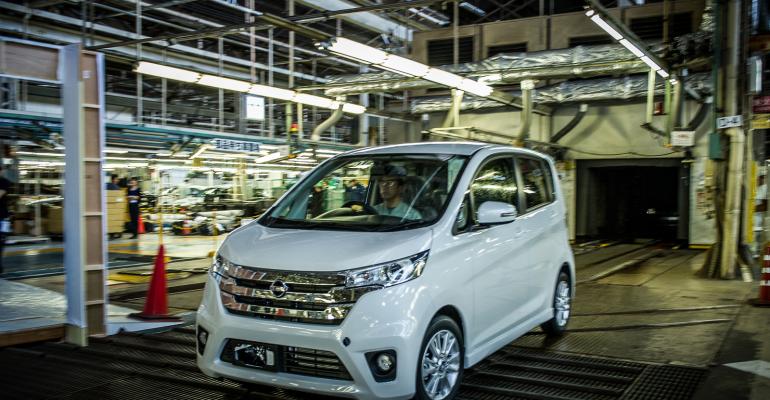TOKYO – Mitsubishi gets some good news after a week which saw its market cap and share price tumble 50% following to the April 20 disclosure of a fuel-economy-cheating scandal in Japan.
In a statement issued Wednesday in the U.S., the automaker reports it had conducted an internal audit of vehicles sold in the American market (model years ’13 through ’17) and confirmed previously submitted data to the EPA was accurate.
Mitsubishi sells the Outlander, Outlander Sport, Lancer, Lancer Evolution and Thailand-built Mirage in the U.S. market.
According to the statement, the audit “confirms that fuel-economy testing data for these U.S. market vehicles is accurate and complies with established EPA procedures.”
The automaker conducted the audit in conjunction with Mitsubishi Motors R&D America and has reported the results to the EPA, California Air Resources Board and U.S. Department of Transportation.
“If true, this enormously simplifies the problem for them,” CLSA analyst Chris Richter says. “Given that cheating so far is related to a specific type of testing in Japan, limiting the problem to Japan will make the problem easier to deal with moving forward.”
Still to be confirmed is whether vehicles sold in Europe and Asia, Mitsubishi’s two largest volume markets, are affected.
But although the EPA has yet to confirm the results, the fact that the Mirage is covered by the audit is encouraging news for the automaker since the car is one of the main models built by Mitsubishi Motor (Thailand) at its 4-year-old Laem Chabang assembly plant.
In fiscal 2015, Mitsubishi sold a combined 557,000 vehicles in Europe and Asia, accounting for 45% of global sales.
Also still to be confirmed is the number of models in Japan that are affected and for how many years the automaker overstated fuel-economy data. This probably will take several months to determine. But at the automaker's April 20 Tokyo news conference, management indicated without providing details that cheating dated back as far as 1991.
eKing Out, Better Dayz Ahead?
But if test-data inflation is limited to the four models the automaker reported April 20 – the Mitsubishi eK Wagon and eK Space and Nissan-badged Dayz and Dayz Roox – the fallout likely will be manageable.
When Mitsubishi and Nissan introduced the eK Wagon and Dayz, respectively, in June 2013, they advertised the cars as best in class with mileage ratings of 69 mpg (3.4 L/100 km). Tests in Japan showed they weren't.
Mitsubishi sold 845,000 cars in Japan from April 2013 to March 2016, more than half of them 0.66L mini-cars to Nissan.
The Reuters news agency, quoting a Nomura Research Institute estimate, reports the financial hit could be as high as ¥166,000 ($1,530) per car. Thus, 625,000 affected models would result in a ¥103.7 billion ($934 million) expenditure.
The automaker, in announcing financial results this week, disclosed it has ¥462.4 billion ($4.3 billion) in cash and cash equivalents. That means it could cover ¥107.4 billion ($1 billion), perhaps even ¥214.8 billion ($2 billion) in fines and penalties, most likely in the form of tax breaks it may have to refund on sales of the four models that all qualified as high-mileage, low-polluting “eco” cars.
Hyundai and Kia, South Korea’s top two automakers, paid slightly more than $300 million in fines, rebates and loss of greenhouse-gas credits when they were caught overstating fuel-economy numbers on an estimated 900,000 cars between 2011 and 2013.
Mitsubishi’s admission of exaggerating fuel-economy this week largely overshadowed the automaker’s Wednesday announcement it set a record in fiscal 2015 with earnings of ¥138.4 billion ($1.3 billion) on 8-year-high sales of ¥2.3 trillion ($20.9 billion) for a 6.1% operating profit margin.
The company also reported it has reduced its debt load to ¥29.2 billion ($269 million), a fraction of the bloated ¥2.0 trillion ($18.5 billion) it faced in 1997 following the Asian financial crisis. Mitsubishi’s debt-to-equity ratio at the time ballooned to 570%. It now is less than 5%.
Whether the mileage-fudging disclosures change the automaker's medium-term business outlook – Mitsubishi was projecting fiscal 2016 earnings of ¥140 billion ($1.3 billion) on sales of ¥2.35 trillion ($22 billion) – is too soon to say in part because the Japanese market accounts for only 20% of volume sales, including OEM sales to Nissan, and none of its profits.
The Asian market generated ¥74.9 billion ($690 billion), or 54% of operating income, in fiscal 2015, with most of the rest divided among Europe, North America, Australia and Brazil.
Japanese operations accounted for a ¥2.4 billion ($22 million) operating loss.





